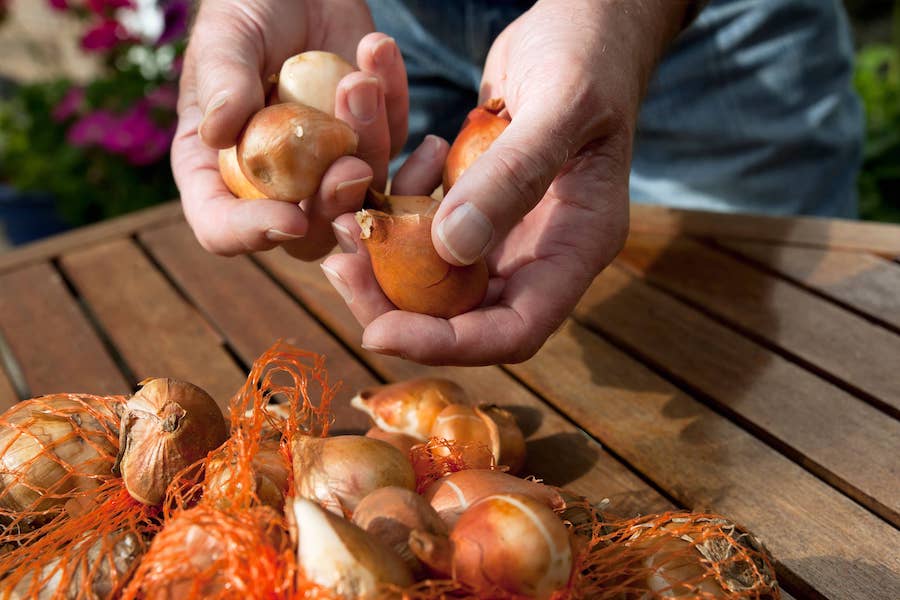This is why you should plant your tulip bulbs in November
You may have already planted other spring-flowering bulbs, but tulips do well left until later
Many of us will have already planted our spring-flowering bulbs, including daffodils, crocus and grape hyacinths – but holding back tulips until November may reap greater rewards.
So says Richard Wilford, horticulturist and head of garden design and collection support at the Royal Botanic Gardens, Kew, and author of The Plant Lover’s Guide To Tulips (Timber Press).
“It’s because of where they come from in the wild, which is mostly from Central Asia, where they have very long, dry summers. They’re very happy being left out of the ground until November or even early December, because they’ve adapted to survive these really dry conditions in the wild,” he explains.
“Even though the tulip (bulbs) you buy probably come from Holland, that wild species DNA is still in them, so they still have that same characteristic even though they’ve been very highly bred.”
Planting later avoids autumn rains
Wilford adds: “It’s not that you can’t plant them in September and October, but if you put them into very wet ground in September, they sit there before they start to grow in damp soil, so they’re more likely to get fungal diseases.”
It also reduces risk of tulip fire
View this post on Instagram
Tulip fire is one of the most common fungal diseases among tulips. It can get into the skin of the bulb, resulting in mouldy patches on the plants the following spring, Wilford warns.
“It can strike at any time when they’re in the ground. The disease can get into the bulb, or it might get on to the leaves and flowers from other plants when they’re in flower. There’s no specific time that the fungal disease arrives. It’s just that if you can leave tulip planting ’til November you’re less likely to get it in the bulb.”
Dampness causes many fungal diseases, but you won’t see evidence until you get blotches on the leaves in spring.
View this post on Instagram
“There could be pale patches and circles and the growth will be distorted, which will spread to the flowers, which will be twisted.”
Once tulip fire appears, it will start producing spores which will spread to other tulips, Wilford warns. “The spores will get into the soil, then if you plant tulips again the following year, it will get into the bulbs at that point.”
By November a lot of fungal activity will be lessened, he maintains, as we enter winter.
What about planting in pots?
Your tulips are less likely to succumb to fungal disease if planted in pots, he adds. “They don’t like damp, humid air when they are in growth. Pots are above the ground, so they get better air movement, which keeps them drier.”
In the coldest periods, put the pots next to the house to stop them freezing solid, which can kill the bulbs.
View this post on Instagram
Do they need a lot of cold to do well?
“They don’t need longer cold. The most important thing is that they are in a warm, sunny spot and have good drainage. They are very resistant to cold – where they come from has a very extreme climate, hot and dry in the summer but below freezing in the winter. They are quite tough plants, in that sense.”
Why do other bulbs fare better planted earlier?
Wilford explains: “You’re meant to plant daffodils in September and October, because they are not so good at staying out of the ground for a long period. They are fine for three or four months, but if you leave them in a bag in the open until November or December, they are going to start desiccating, whereas tulips are very resistant to that. They are very resilient to being left out of the ground, as long as they are not too hot and are kept dry.”
Borders will also be clearer in November
“In a year like this year, when summer kept going right through September, trying to get bulbs in between plants that are still growing and flowering isn’t as easy as if you wait ’til November, when you start cutting a few things back and create a bit of space.”
Are there any other rules for planting tulips in winter?
Don’t try to plant them out if the ground is frozen. Wait ’til it thaws, which is less of a shock to the bulb, and make sure they have good drainage, Wilford advises. For tulips in pots, don’t let them dry out – put them on pot feet and give them adequate drainage.
Plant them somewhere which will be sunny in spring, and not in a damp corner – although you do want to make sure the soil is damp, but not waterlogged – until you see the noses coming through the top. Once the growth is visible, water them and give them diluted tomato feed once a month, he adds.
The Press Association
Latest posts by The Press Association (see all)
- Dame Kelly Holmes: ‘Getting old is a privilege but ageing I don’t like’ - April 27, 2024
- 9 of the most iconic dance scenes in movies - April 27, 2024
- Why is melanoma on the rise? As new personalised ‘gamechanger’ skin cancer jab is tested - April 27, 2024
- King to resume public duties after positive cancer treatment - April 26, 2024
- 3 recipes to make from the new Hairy Bikers cookbook - April 26, 2024





















